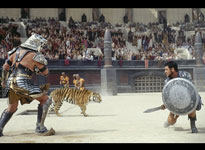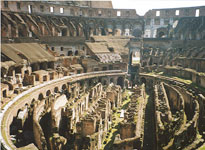Occupation as a gladiator in Roman times
Enlightenment in Roman Empire is a inhuman pastime, very strange to today's society. However, in reality the feeling of competition is also a highly professional sport like today's football. From the beginning, I was able to catch many ethnic groups in southern Italy in religious funerals.

A scene from the Giac Giong film depicts the fighters fighting a tiger at Colisée.
In the middle of the 3rd century BC, enlightened to enter the city of Rome and lost its sacred nature to become a secular game. Besides the duel match between martial artists, there is also the kind of duel between people and animals or beasts fighting against each other.
Although the enlightenment plays an important role in Roman society, it was not until 80, under Emperor Titus, Rome opened its own arena for the enlightenment: Colisée arena was capable of accommodating 50,000 - 80,000 viewers. . Roman architects built an elliptical arena, surrounded by rows of ladder-shaped chairs.

Colisée Arena
Colisée Arena is taken from the nickname Colosse for the Emperor Neron with the statue of King Neron erected. Seating in the arena is divided into many areas depending on social theft. The 'crazy chicken' zone is a high corridor for people to sit or stand and have reserved places for women. The lower ladder-shaped chairs have seats for guild organizations such as traders, teachers . 14 rows of seats are reserved for knights, a rich class in society, often recruited The tomb formed a cavalry army.The courtyard is the place for senators, their seats are made of marble with their names engraved on the seat and the name is only removed when it is dead. In the royal area of the royal family, the emperor saw the duel with relatives and guests but was absolutely devoid of women in this area, including the queen. The Empress will sit on the other side of the stage in the lot for the main officials.
The surface of the stadium consisted of many laminated woods covered with sand above and will be filled with water if there is a water battle scene. Under the playing field, there are two-storey confining places with narrow paths. He teaches animals to bring animals to each of the private stables downstairs. After that, the barn is pulled by winch to the upper floor, from which the animal will go to the stadium. In order to protect the sun, the ancient architects built a winch system and a light-colored zipper on the roof of the arena. 73 between the cover cloth is a circle tied with a rope to allow light to pass through.
The gladiator consists of many types: fish-hat fisherman fighters and fish-shaped hat fighters fighting with boxers capturing the form of net fishermen chasing fishes or fighting with knights carrying lattice nets fish; The combatant boxer consists of two people standing on each other's backs: the strikers and the javelins; boxers hit the helmet with the shield and sword against the boxer.
- Discover the 'whole vegetable' diet of ancient Roman gladiators
- Why does the ancient Roman gladiator statue have a strange posture?
- Gladiator - Roman symbol of sex
- The legend of the gladiator at the Roman villa
- The truth about the 'standard body' of the ancient gladiator
- Confused about the sexual assault, the tyranny of Roman times
- Discover the Roman arena in Austria
- The secret to survival in ancient Roman society is the thick side!
- Discovered the gladiator in the UK
- Life of a citizen of the Roman Empire in ancient times: Every day must survive
- The oldest computer in the Roman era
- 'Gladiator' grabs UFOs
 Discovered an ancient centipede fossil 99 million years old
Discovered an ancient centipede fossil 99 million years old Discovered bat-like dinosaurs in China
Discovered bat-like dinosaurs in China Discovered a 200-year-old bronze cannon of the coast
Discovered a 200-year-old bronze cannon of the coast Discover 305 million-year-old spider fossils
Discover 305 million-year-old spider fossils